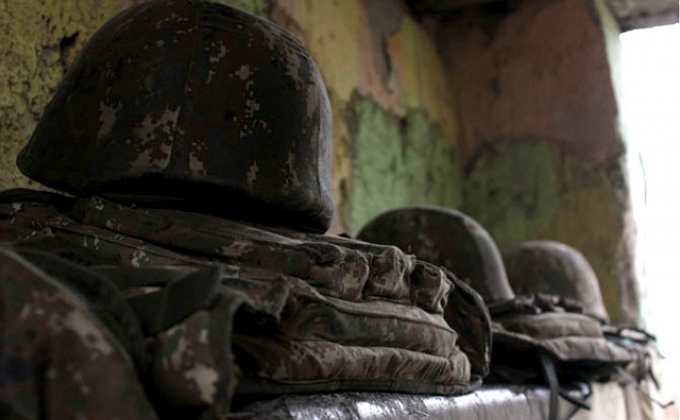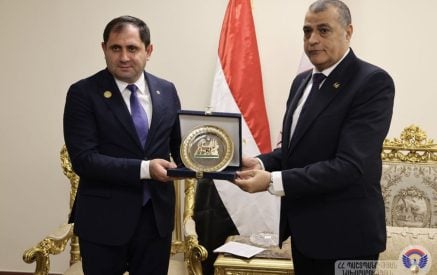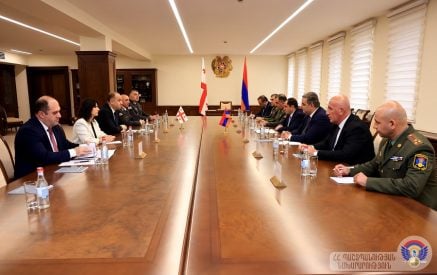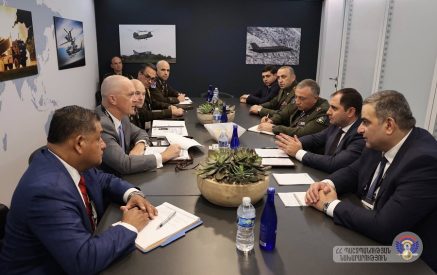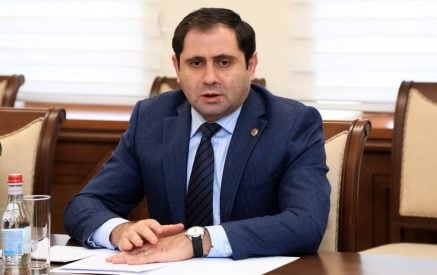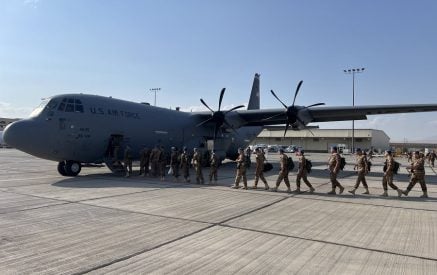As part of their annual trip to Armenia, the 11th graders and faculty members of the Hollywood-based Pilibos Armenian School visited families of ten fallen soldiers across the country, delivering a total of $11,250 in financial relief to the parents and spouses of the servicemen who gave their lives for Artsakh during and in the aftermath of the Four Day War.
These visits were organized through the Armenian Youth Federation’s ‘With Our Soldiers’ campaign in Armenia, which provided the logistical support for distributing the funds, raised by Pilibos students during the past year and taken with them to Armenia earlier in May. You can watch the interview of Pilibos students with Yerkir Media here:
“It was a truly humbling experience for our students, most of whom were visiting Armenia for the first time, to meet the families of our fallen soldiers,” said Kevork Sarkissian, the chair of the Armenian department at Pilibos who accompanied the students during the trip. “We are eternally grateful to our fallen heroes for the ultimate sacrifice that they have made for our country.”
Below is the list of fallen soldiers whose families were visited by the Pilibos Armenian School students and faculty as part of their trip to Armenia:
Robert Abrahamyan (b. 1993) was from the village of Taperakan in the Ararat province of Armenia, where he lived with his parents, Melanya and Abraham, and his wife, Knarik, whom he had married a little more than a year ago. Robert’s first child, a son named Abraham, was born earlier this year. Robert was described as a kind, respectful, and lively individual by Taperakan residents. He had been on the front lines for only a couple of days before being killed by enemy fire near Talish under unclear circumstances on April 10th. Abrahamyan’s family was given $1,000 (another $250 will be delivered in the coming days). To learn more about Robert and his family, watch this video:
https://www.youtube.com/watch?v=vjhMZGGeT-o
Bagrat Aleksanyan (b. 1995) lived in the Arabkir district of Yerevan, though his family was originally from the Hadrut district of Artsakh. Bagrat served in the military along with his brother, Samvel; both brothers had returned from Russia to join the military to defend their country, including their native Hadrut. Prior to joining the military (2014), Bagrat had graduated the Armenian-Greek State College (2013). Bagrat died on April 2nd during battles near Jabrail (Jrakan); he was among the 18 servicemen whose tortured bodies were returned to the Armenian side on April 10th.Aleksanyan’s family was given $1,000. To learn more about Bagrat and his family, watch this video:
https://www.youtube.com/watch?v=zCeK6KFgrdo
Tigran Berakchyan (b. 1997), another hero from the Arabkir district of Yerevan, was the oldest of the two sons in the family and was known for his patriotism. His brother, Vahram, remembers that Tigran insisted that he should serve in Artsakh, on the front lines, and nowhere else. His family knows very little about the circumstances of his death; Tigran was one of dozens of soldiers who gave their lives for Artsakh in the early days of April in battles near Jabrail (Jrakan). Tigran was truly proud to serve in the Armenian Army, and he refused to change into civilian clothing when he would return home from Artsakh on vacation. Berakchyan’s family was given $1,000. To learn more about Tigran and his family, watch this video:
Aramayis Mikayelyan (b. 1996) was the oldest of the two sons of Gevorg Mikayelyan and Lilit Avagyan from the village of Voskehat (near Echmiadzin). He went to school for sculpting, and some of his works (including unfinished pieces) were displayed next to his picture in the family’s home. On the day of his death (April 4th), Aramayis spoke on the phone with his brother, Arsen, and said that the situation on the border was difficult and that he was going to the front lines. The family repeatedly stated that due to health reasons, Aramayis was never supposed to go to be on the military positions at the line of contact, but that requirement was ignored by the military command. Aramyis Mikayelian died from enemy fire on April 4th near Jebrail (Jrakan). Mikayelyan’s family was given $1,000. To learn more about Aramayis and his family, watch this video:
https://www.youtube.com/watch?v=xaSE9Dg9XJA
Due to scheduling conflicts, the money was delivered to Aramyis Mikayelyan’s family by the representatives of the WOS campaign, and not staff or students of Pilibos.
Sasun Mkrtchyan (b. 1989) was a career office serving in one of the special units of Armenian Armed Forces. He had returned home to Yerevan on April 1st, but went back to the front lines immediately upon hearing about the Azeri attacks. The hero’s parents, Fahrad and Narine, retell the stories of the soldiers, who fought with their son and told them that they would not be alive if not for Sasun’s sacrifice on their behalf. Born into a family of Sasuntsis, Sasun Mkrtchyan loved the Army and stayed behind as a career office upon completion of his mandatory service. He was an accomplished athlete, who practiced boxing since the age of 10. The fallen soldier was known for his love of children: he spent hours playing with his sister’s son and planned to have four kids himself. Sasun and his girlfriend, Gohar, were going to get engaged in April. Sasun Mkrtchyan was killed on the night of April 2nd while leading the fight to take back one of the lost positions near Talish. Mkrtchyan’s family was given $1,000. To learn more about Sasun and his family, watch this video:
https://www.youtube.com/watch?v=lQLOrTFHmsc
Hrach Muradyan (b. 1983) left behind his wife, Anna, and three children, Gohar (b. 2008), Armine (b. 2009) and Samvel (2013). Hrach was supposed to return home in mid-April in order to go through six month-long military preparedness courses, but was wounded by a tank fire on April 7th during battles near Talish while attempting to save the life of a wounded friend/serviceman. Two more soldiers came to help Hrach and his friend during the attack. Ultimately, three of the soldiers survived; Hrach Muradyan did not. Hrach’s family lived in a rental apartment in Yerevan, and his wife and children received a new house in the capital from the Yerevan City Council in the aftermath of the Four Day War. Muradyan’s family was given $1750. To learn more about Hrach and his family, watch this video:
https://www.youtube.com/watch?v=gLPm9TzbUT8
Hovsep Kirakosyan (b. 1988) was born in Apaga (near Echmiadzin), a village predominantly populated by descendents of Western Armenian refugees from Sasun. Hovsep dreamed about a military career since childhood, and entered a military academy despite the objections of his parents. Before leaving for the front lines in the midst of the Azeri attack, Hovsep instructed his wife of five years, Mariam, to hide with their two children, Erick and Gegham, in the basement of their house in Mataghis. Mariam, along with her children; was able to escape to Stepanakert in a friend’s car, which was continuously fired upon by the Azeris. Hovsep was a commander of a unit of 25 soldiers; he was the only one in the unit to die on the night of April 1. The Captain’s friends told the family that Hovsep had left the trenches and went head-to-head against the Azeris and even after being wounded, he urged his unit to continue fighting. Unfortunately, the 28-year old hero’s wounds were mortal and he died soon after being carried back into the trenches by his soldiers. Kirakosyan’s family was given $1500. To learn more about Hovsep and his family, watch this video:
Kyaram Sloyan (b. 1996) was born into a family of a Yezidi freedom fighter, Kyalash in the village of Artashavan (Aragatsotn province, Armenia), and was the youngest of the family’s four children. Kyaram was to return home from his compulsory two-year military service in July, but was among one of the first soldiers who faced the Azeri attacks on the north-eastern (Martakert) section of the Artsakh border on the night of April 2nd, fighting to defend the Armenian positions under the leadership of Captain Armenak Urfanian (see below). He disobeyed his commander’s order to retreat, and died fighting until the last bullet. Kyaram was beheaded by the barbaric Azeri fighters, and his family had to endure the ordeal of reburying their son after Kyaram’s head was returned to the Armenian side during an exchange of bodies in mid-April. Soon, one of the classrooms in the school that Kyaram attended will be named after the young soldier. Sloyan’s family was given $1000. To learn more about Kyaram and his family, watch this video:
Armenak Urfanyan (b. 1990) had joined the Army in 2007 and had served his country as an officer in the Armed Forces since then, having attained a rank of a Captain and becoming a commander of a battalion. His family had lived in St. Petersburg, Russia, since 1992, but they returned to Armenia to prevent Armenak and his brother, Franz, from losing their Armenian identity and forgetting their native language. Armenak returned home at the end of March, to spend the Easter with his family and fiancé; that was the last time his relatives saw Armenak. Facing the overwhelming forces of the Azeris during the attack on the night of April 2nd, Urfanyan ordered his unit to retreat and continued to fight (with Kyaram Sloyan) the invaders for two hours, destroying a tank and more than 10 enemy soldiers before detonating a grenade that killed him and the approaching Azeris. Armenak always carried grenades with him, saying that he would rather blow himself up than surrender to the enemy. An unexploded grenade was found in his pocket by the soldiers who retrieved Armenak’s body. Urfanyan’s family was given $1000. To learn more about Armenak and his family, watch this video:
https://www.youtube.com/watch?v=tlVnzF5pmDw
Zhora Yesayan (b. 1996) was the oldest of his family’s three children (all sons), who, along with his younger brother, Arsen, was serving in the Armenian Armed Forces. A native of Darbnik village (Ararat province), Zhora was killed near Jabrail (Jrakan), and his body was among the 18 tortured bodies that were returned to the Armenian side in mi-April. The young man was described as very active and courageous by family members and teachers. Zhora’s father, Arthur, was the bus driver for the village, whose work provided him with the opportunity to care for his three sons and his sick wife, but he lost his job after his son’s death and the family is now in a difficult financial situation. Yesayan’s family was given $1,000. To learn more about Zhora and his family, watch this video:
As mentioned earlier, all visits to the families of fallen soldiers are conducted in accordance with a protocol developed by the ‘With Our Soldiers task’ force in the US. Along with the funds, a letter of support from the AYF Western Region membership and the ‘With Our Soldiers’ task force was also delivered to each family by Pilibos students, and a receipt was obtained from the families to be used as proof for the delivery of the money.
The AYF’s ‘With Our Soldiers’ campaign, originally launched in 2012, was restarted in the aftermath of the Four Day War with the aim of providing assistance to the families of the fallen soldiers. To learn more about the campaign or to make a donation today, you can visitwww.withoursoldiers.com.
Founded in 1933, the Armenian Youth Federation is the largest and most influential Armenian American youth organization in the world, working to advance the social, political, educational and cultural awareness of Armenian youth.




















































